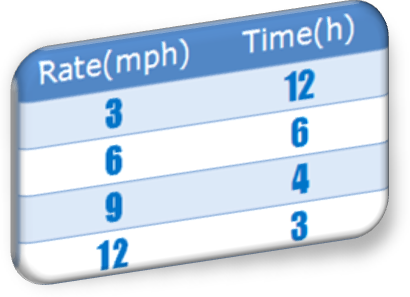Inverse Variation can be modeled after any equation in the form where
. The constant of variation is k.
The table to the left models the time it would take to roller blade 36 miles at various speeds. As the rate increases the amount of time to travel 36 miles decreases. If the rate data is examined more closely and focus is placed on the times of 3, 6 and 12 hours, it should be come clear as the rate is doubled, the amount of time is cut in half.
Since the product is 36 for each pair of numbers, this is an inverse variation problem and the product is the constant of variation for this data. Letting x be the rate and y be the time, one equation to model this data is . A more useful equation is
. Figure 2 is the graph of the inverse variation modeled in this problem.
Critical Thinking – Inverse Variation
Why is a more useful equation than
?
Write your responses in the comments section.
Modeling Inverse Variation
This problem involves finding the equation or function that models a given inverse variation. This is a two step process:
- Multiply the given x- and y-values
- Substitute the product into
Before just memorizing this two step process, it would be better to understand what these two steps are ‘doing’ mathematically. In step 1, multiplying the given x- and y-values calculates the constant of variation. The second step is to substitute the constant of variation into one of the acceptable forms of the inverse variation equation.
Example 1 – Modeling Inverse Variation
Suppose that x and y vary inversely and x = 7 and y = 5. Write an equation that models the inverse variation.
Definition of Inverse Variation
Substitution Property of Equality – Step 1 from above
Simplify
Symmetric Property of Equality
Step 2 from above
Final Answer
Identifying Inverse Variation
When given a table of values, it is often important to be able to identify the equation modeling the data. To determine if a table of values is indeed an inverse variation, all of the data pairs must have the same product. This is because of the definition of an inverse variation and how the constant of variation is calculated. So, to identify a table of values as an inverse variation, one must test the products of all the available data. If the products are all equal, then the data models an inverse variation and by find the products, the constant of variation is already known.
Example 2 – Identifying Inverse Variation
Is the relationship between the variables in figure an inverse variation? If so, then write the function that models the inverse variation.
As state above, first find the product of all pairs of numbers:
.
Since all pairs of corresponding numbers form the same product, this table of values models an inverse variation with the constant of variation being 1.4. Therefore the function to models this data:
.
If I don’t write this at the end of every blog article, I should start. Use the comments section for any questions you may have.
Filed under: Algebra 2, Equations and Graphs, Inverse Variation | Tagged: Algebra 2, Identify Inverse Variation, Inverse Variation, Modeling Inverse Variation | 1 Comment »




